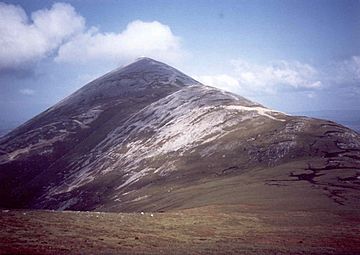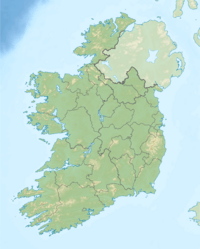Croagh Patrick facts for kids
Quick facts for kids Croagh Patrick |
|
|---|---|
| Cruach Phádraig The Reek |
|
 |
|
| Highest point | |
| Elevation | 764 m (2,507 ft) |
| Prominence | 639 m (2,096 ft) |
| Listing | P600, Marilyn, Hewitt |
| Naming | |
| English translation | (Saint) Patrick's Mountain |
| Language of name | Irish |
| Geography | |
| OSI/OSNI grid | L906802 |
| Topo map | OSi Discovery 30, 31, 37 or 38 |
| Climbing | |
| Easiest route | Hike |
Croagh Patrick (Irish: Cruach Phádraig, meaning (Saint) Patrick's Stack), also called the Reek, is a famous mountain in Mayo, Ireland. It stands about 764 meters (2,507 feet) tall. This mountain is a very important place for pilgrimage (a special journey for religious reasons).
Croagh Patrick is located about 8 kilometers (5 miles) from Westport. It is near the villages of Murrisk and Lecanvey. It is the fourth highest mountain in Mayo. Every year, on the last Sunday in July, many pilgrims climb it. This day is known as Reek Sunday. The mountain was shaped by a glacier during the last Ice Age. This glacier flowed into Clew Bay.
Contents
What's in a Name?
The name Croagh Patrick comes from the Irish words Cruach Phádraig. This means "(Saint) Patrick's stack" or "Patrick's Mountain". Locally, people call it "the Reek". A "reek" is an old Irish-English word for a "rick" or "stack" of something.
Before Christianity, the mountain was known as Cruachán Aigle. This name is found in old Irish stories and records. Cruachán means a small stack. The meaning of Aigle is not fully clear. It might come from the Latin word for "eagle" or be a person's name.
The Marquess of Sligo, a noble family from nearby Westport House, has titles linked to the mountain. These include Baron Mount Eagle and Earl of Altamont. These names also come from older names for Croagh Patrick.
The Pilgrimage Journey
On the last Sunday of July, thousands of people climb Croagh Patrick. They do this to honor Saint Patrick. Tradition says that Saint Patrick spent forty days fasting and praying on the mountain's top in the year 441. There is a small chapel at the summit where special services are held.
Many pilgrims climb the mountain barefoot. They do this as an act of penance, which means showing sorrow for past actions. This tradition has continued for a very long time.
Some pilgrims also perform 'rounding rituals'. This means they pray while walking in a circle around certain spots on the mountain. They walk in a sunwise direction (like the sun moves across the sky). In the past, during the Middle Ages, pilgrims would carry stones. They would add these stones to a cairn (a pile of stones) at the top or halfway up the mountain. This was thought to bring good luck. This practice is similar to other ancient pilgrimage paths, like the Camino de Santiago.
Some people believe that the pilgrimage started even before Christianity. They think it was linked to an old festival called Lughnasadh. There have been concerns that so many visitors cause erosion. This makes the mountain harder and more dangerous to climb.
The Ancient Pilgrim Road
Patrick's Causeway (in Irish, Tochar Phádraig) is an old pilgrim road. It is about 30 kilometers (19 miles) long. This road goes from Ballintubber Abbey all the way to Croagh Patrick. Even though it is named after Saint Patrick, the road is much older than Christianity. Experts believe it was built around 350 AD. It was the main route from Rathcroghan, which was the seat of the Kings of Connacht, to Cruachan Aigle (the old name for Croagh Patrick).
The Tochar Phadraig route has been brought back to life. It is now a cross-country pilgrimage trail for tourists. Walking the entire 30-kilometer route takes about 10 hours.
Chapel at the Summit
There has been a chapel on the summit of Croagh Patrick since the 5th century. It was called "Teampall Phádraig." In 1994, archaeologists found the remains of an old foundation at the top. This showed where the ancient chapel once stood.
A small chapel was built on the summit and officially opened on July 20, 1905. On July 31, 2005, a special plaque was put up to celebrate its 100th birthday. Michael Neary, the Archbishop of Tuam, unveiled the plaque.
Gold Discovery
In the 1980s, a surprising discovery was made on the mountain: gold! Geologists found a seam of gold within the rock. They estimated there were about 14 grams of gold in every tonne of rock. This could mean over 300,000 troy oz of gold in total. That would be worth a lot of money!
However, local people were worried about mining. A group called the Mayo Environmental Group, led by Paddy Hopkins, strongly opposed it. Because of this local resistance, the Mayo County Council decided not to allow gold mining on Croagh Patrick.
Gallery
-
Distant view of mountain from Westport
Images for kids
See also
 In Spanish: Croagh Patrick para niños
In Spanish: Croagh Patrick para niños












